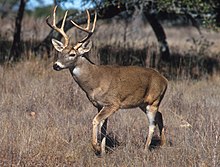
Back حيوان مجتر Arabic Daskirier Breton Preživar BS Remugant (digestió) Catalan کاوێژکەر CKB Přežvýkavec Czech Drøvtygger Danish Rumiante Spanish Hausnarketa (fisiologia) Basque نشخوارکننده Persian
| Ruminants Temporal range:
| |
|---|---|

| |
| White-tailed deer | |
| Scientific classification | |
| Domain: | Eukaryota |
| Kingdom: | Animalia |
| Phylum: | Chordata |
| Class: | Mammalia |
| Order: | Artiodactyla |
| Clade: | Cetruminantia |
| Clade: | Ruminantiamorpha Spaulding et al., 2009 |
| Suborder: | Ruminantia Scopoli, 1777 |
| Families | |
A ruminant is an ungulate that eats and digests plant-based food such as grass.
Ruminating mammals include cattle, goats, sheep, giraffes, bison, yaks, water buffalo, deer, camels, alpacas, llamas, wildebeest, antelope, pronghorn, and nilgai. All of them are Artiodactyla, cloven-hoofed animals.[1]
The word "ruminant" comes from the Latin word ruminare which means "to chew over again". They have a more complex digestive system than other vegetarians. Digestion of food is always done mainly by microorganisms, and in ruminants it is digested twice.
An example of a grass-eater which is not a ruminant is the horse. Horse excrement leaves the work of digestion half-done. This is very obvious to see in comparison to that of a ruminant.